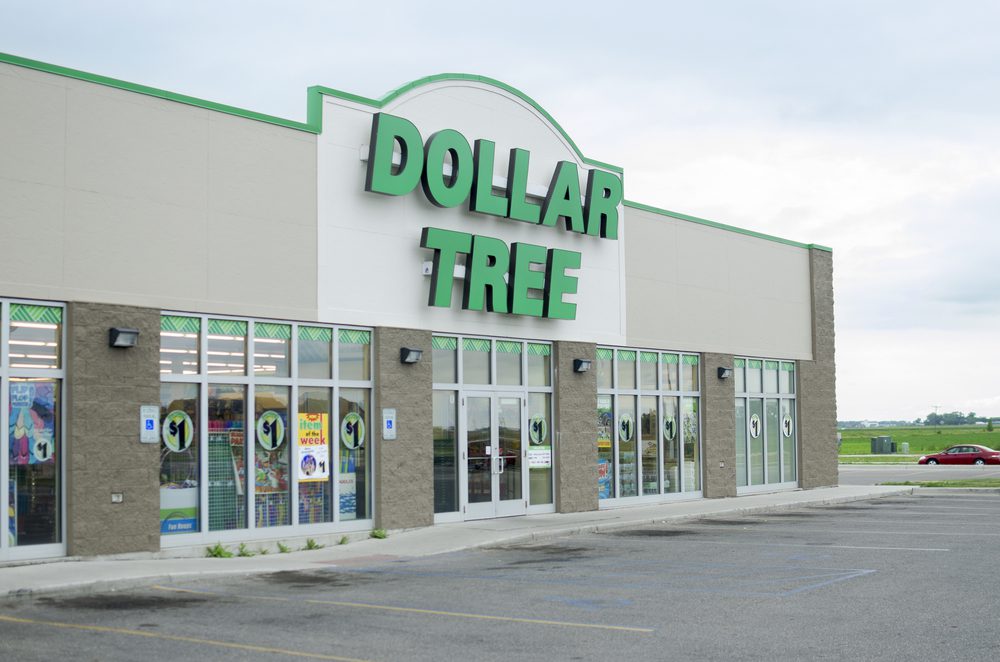
Dollar stores have become so prevalent in the U.S. consumer landscape, you can hardly turn a corner without bumping into one… or two, or three. They’re everywhere, attracting customers with low prices and convenience alike. Not to mention the fact that the word ‘dollar’ in the name implies huge savings when shopping with them.
But are all these marketing strategies to be trusted? Should you give up on other supermarket chains in favor of dollar stores? Well, that’s for you to decide.
We have, however, 22 secrets these stores are keeping from you. Read on and tell us what you think about these strategies and tidbits.
They Aren’t Always Cheaper
If you’re expecting to come out cheaper when shopping at a dollar store than when shopping at, say, Walmart then you wouldn’t technically be wrong. The vast majority of items are cheaper, but this could make you unaware of instances when this isn’t the case.
After all, if you’re expecting everything to be low priced then you’re less likely to shop around. Furthermore, you’ll also pay less for less in a dollar store whereas you’ll find better deals when buying in bulk in another supermarket. Figuring all of this out is a delicate balancing act.
Just keep this in mind when you’re filling your shopping cart in order to ensure you’re getting the best deals.
Some Items May Cost More than $1
While Dollar Tree does make good on the promise of selling goods for one dollar or less, not all such stores do. Take Dollar General and 99 Cents who offer goods at various price points. Even Family Dollar, which is owned by Dollar Tree is just as misleading.
But you have to admit it’s a pretty clever tactic on their part. If one or two items on your shopping list go above this threshold, are you really going to put them back on the shelf and shop elsewhere? You might let them slide or you might not even notice the price difference in the first place.
Smaller Items = Cheaper Items
Low prices come with certain sacrifices. Most of the time, it’s the sizing of a product that gets smaller in order to keep costs low. So don’t be surprised if you’ll be getting less shampoo or toothpaste when you shop next.
Even more upsetting, this trend will likely continue. Items will continue to shrink as inflation goes up, so make sure to compare how much you’re getting, not just the price tag.
Don’t believe us? Next time you’re out shopping, stop by a Walmart and look for the same items as you’re used to getting from your favorite dollar store and see for yourself!
Name Brands Aren’t Always a Bargain
Even if you forgo most name brands and try out generic ones instead, it may be hard to really give up on a specific item you’ve grown to love over the years. How about that detergent that you love the scent of or the box of cereal you grew up with?
If they’re available at the dollar store, they might not be a bargain. They’re typically smaller to make up for the low price or they might cost more than one dollar anyway. In most cases buying them from here could negatively impact your savings, so splurging on one or two from a grocery store might be more beneficial in the long run.
Despite Cutting Costs They Want You to Spend More
It’s a tale as old as time. Retailers will do anything they can to cut costs while expecting consumers to spend more. Dollar stores are not foreign to this idea, either.
Let’s look at Dollar General’s example. They wanted to expand their 30% gross margins by implementing a series of changes. By putting anti-theft tags on all items while making stores smaller would prevent shoplifting. They also wanted to manage and expand their own fleet of trucks while also expanding their product lines. Most importantly of all, they sought outsourcing from countries that are even cheaper than China.
But how does this affect the average customer? Well, instead of lowering prices they’d much rather rely on impulse buying goods that are more expensive.
They Are Betting Against You
Dollar stores thrive in communities with lower incomes- they know it, we know it. But the disappearance of the middle class doesn’t seem satisfactory enough. To put it simply, analysts say that in order for dollar stores to thrive, the birth of an underclass in America is necessary.
So the jobs that went away? All these retailers want them to never come back. As such, more and more people will turn to them rather than regular grocery stores. The less money consumers have, the more money will get siphoned in their pockets.
Now that’s a particularly gloomy thought, isn’t it?
And They Also Feed off Misery
Thanks to the Pew Research, we know that just 50% of the U.S. wealth is held by middle-income households. Back in 1973, this figure was at 61%. That’s quite a huge drop over such a short period of time.
Due to these changes in economics and income, a lot of retails and malls in middle-class areas shut down, allowing for dollar stores to swoop in and fill a much-needed gap. Unsurprisingly, this is also timed with the rise in food stamps and the struggles of many Millenials to thrive after the recession.
Suffice it to say, wherever financial struggles come to life, dollar stores come into view.
They Have a Type of Shopper in Mind …
Dollar stores know exactly what kind of shoppers they want to walk through their front doors. Todd Vasos, the CEO of Dollar General even said as much in an interview with Goldman Sachs.
They’re interested in women that live in a two-income household that makes $40,000 per year (before taxes). Her job has to be stable with no wage growth and her disposable income should be around 2%, totaling up to $800 per year. Vasos also knows that price changes of as little as a dime would garner a negative response from such an ideal shopper.
… And They Actively Seek out That Type
With such a clear picture of their ideal shopper in mind, it’s no wonder that dollar stores know exactly where to open up new locations. CityLab has looked at the data and has found that most dollar stores do extremely well in areas where residents are making below the median income while living at high rates of poverty.
High rates of smoking, obesity and lower levels of education are also magnets for new dollar store locations. Also, if an area has a higher crime rate it also makes it ideal for a new dollar store.
The next time you see a store pop up, try to look around and spot all these factors.
They Also Attract Wealthy Customers
Despite dollar stores’ aim to target a certain demographic, it turns out that well-off shoppers seek them out as well. The New York Times Magazine found that as many as 22% of customers make more than $70,000 a year. That’s not an insignificant number. Along with Millenials, they’re the fastest-growing segment of shoppers.
It just goes to show that you can’t really beat a good price, even with a stable income and secure finances.

They Also Attract Wealthy Customers
When we say that dollar stores are everywhere, we really mean it. Forbes found that when it comes to the two biggest dollar chains, Dollar General and Dollar Tree, they have more locations combined than that of the six biggest U.S retailers.
Yes, there are more of them than Walmart, Costco, Home Depot, CVS, Kroger and Walgreens. Let that sink in for a minute…
What about Macy’s, Nordstrom, Kohl’s, Dillard’s, LCPenny, Naiman Marcus, Belk, and Saks/ Lord & Taylor put together? They make up less than 15% of the total number of dollar stores.
Stores May Always Be Messy
If you’ve ever walked into a messy dollar store, you should know that’s the norm rather than the outlier. It’s no wonder since most of them run on minimal staff that often have to deal with more pressing issues than cleaning up and putting things where they belong.
The cash register is, after all, far more important than unpacking boxes cluttered with new items. They also have to move a lot of products very quickly so there’s hardly any time for the workers to make sure everything is in order before a new batch comes in.
So you could say that the disarray in dollar stores is almost there by design.
Wages Are Low at Most Dollar Stores
It should come as no surprise that working at a dollar store won’t make you a millionaire. But you might be shocked by how small the wages actually are.
Here’s what Glassdoor has found. On average, cashiers make around $8 per hour, so around $20,000 a year. Stocking shelves will gain you $8 to $9 an hour. Assistant managers and store managers make around $45,000 and $43,000. Owner-operators could take $52,000 home per year while district managers could make up to $70,000.
Come on dollar stores, you can do better!
Multitasking Is Often a Requirement for Employees
We mentioned how dollar stores will do anything to keep their profit margins high while keeping the overhead low. One ‘tactic’ that they use? Making employees multitask.
Just ask any cashier about everything they’re expected to do. They’ll take on janitorial and security duties too. We think this is particularly unfair, especially seeing as they’re only paid $8 an hour. Clearly, with the amount of work they put in, we think they should be compensated more fairly.
It’s a Two-horse Race …
Considering their target demographic and low, low prices, you might be surprised to find out how much money these businesses make.
Dollar Tree which also owns Family dollars made $22.25 billion in revenue over 15,000 locations. Dollar General, which has 14,500 locations, made more than $23 billion.
So it’s really a two-horse race, considering that a second-tier competitor like Five Belos has only 625 locations!
… But There Are Plenty of Smaller Competitors Too
99 Cents Only, based out of California, has nearly 400 locations. This isn’t the norm, though. Most dollar store chains have far fewer locations. In Central New York, Deal Deals only has around 10 locations.
It might be a good idea to check out the little guys for more variety in items, prices and why not, customer service?
They’re Putting Pressure on Everyone
Competition comes along with any company’s growth. It’s unsurprising to think of the pressure Dollar Tree and Dollar General are putting pressure on big retailers. But smaller dollar stores are also struggling to keep up.
Mom-and-pop operations have been pushed out rather aggressively over the past couple of years, as highlighted by the New York Times. Their presence and supply chains have had disastrous consequences and it’s even safe to assume that in the near future, American consumers will only have two options when it comes to their shopping needs: large retail supermarkets or dollar stores, with hardly anything in between.
The number of dollar stores has grown by 25% from 2011 to 2016, reaching as many as 30,000 locations. Analysts claim that by 2020, those numbers will likely grow to 34,000, so it’s no wonder they’re pushing out so many other businesses.
They Tend to Cluster
You might think that with so many locations, dollar stores are equally distributed around the country. But in fact, CityLab has found that they’re concentrated in blue-collar, working-class states instead.
You’ll find most of them in Ohio, Indiana, Kentucky, Tennessee, and in the Gulf states.
Considering what we know about the target demographic, it’s not surprising they’re concentrating their efforts in certain areas. But we also know that their numbers continue to grow, while more and more well-off Americans shop from them, so don’t be surprised if you’ll soon see them in more ‘affluent’ areas too.

Amazon Is a Thorn in Their Side
As the middle class keeps drifting to lower tiers, you’d think dollar stores would thrive more and more. But another competitor has entered the ring!
Amazon has been giving pretty much every retailer into the sun massive headaches, from online stores to bring-and-mortar ones. Even Dollar Tree and Dollar General, the two leading companies, have had a hard time keeping up with the online behemoth.
Wholesalers and Direct Suppliers save Them Money
Small chains and independent dollar stores alike depend on wholesalers. Access to overproduced products as well as inexpensive imports are the bread and butter of their operations. Why, without them, they wouldn’t be able to shelve such cheap, affordable items.
Large chains, however, have direct deals with name-brand clients directly as well. So it’s no wonder you’ll find familiar items on their shelves.
They’re a Bulk Store in Reverse
Dollar Tree’s Direct to Business program allows charitable organizations and businesses to buy items at bulk prices without charging them a warehouse fee like Sam’s Club or Costco.
They also break up cases and sell items for $1 regardless of the unit price in bulk. Basically, they’re masters of taking advantage of the economics of scale without passing the bulk of those deals onto the consumer.
They Don’t Franchise
With so many locations, you’d think that Family Dollar, Dollar Tree, and Dollar General operate as franchises. They don’t, though! Dollar Tree and Family Dollar operate from its corporate headquarters in Virginia.
You could, however, sell Dollar General products online as an affiliate for a 5% commission and that’s as ‘close’ as you’ll get to doing business with them. Maybe this might seem fair and lucrative, especially considering the dangers of opening a mom-and-pop shop in today’s economic environment!
Now, enough about this. Let’s talk about 4 Things the Best US Grocery Stores Have in Common!










